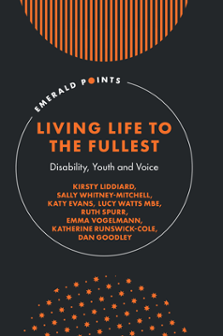
Index
Living Life to the Fullest: Disability, Youth and Voice
ISBN: 978-1-83909-445-3, eISBN: 978-1-83909-444-6
Publication date: 9 May 2022
Citation
Liddiard, K., Whitney-Mitchell, S., Evans, K., Watts, L., Spurr, R., Vogelmann, E., Runswick-Cole, K. and Goodley, D. (2022), "Index", Living Life to the Fullest: Disability, Youth and Voice, Emerald Publishing Limited, Leeds, pp. 165-170. https://doi.org/10.1108/978-1-83909-444-620221010
Publisher
:Emerald Publishing Limited
Copyright © 2022 Kirsty Liddiard, Sally Whitney-Mitchell, Katy Evans, Lucy Watts, Ruth Spurr, Emma Vogelmann, Katherine Runswick-Cole and Dan Goodley
INDEX
- Prelims
- 1. Living Life to the Fullest: Our Project
- 2. Theorising Disability: Towards a DisHuman Perspective
- 3. Co-production, Participatory and Emancipatory Disability Research
- 4. Posthuman Connections: Rethinking Animal–Human Relationships
- 5. Disability and Faith
- 6. Rethinking Sexuality, Our Intimate Selves and Our Relationships with Others
- 7. Labour in the Lives of Disabled Young People
- 8. Making Meaningful Impact in and with Schools
- 9. Desiring Life and Living with Death
- References
- Index